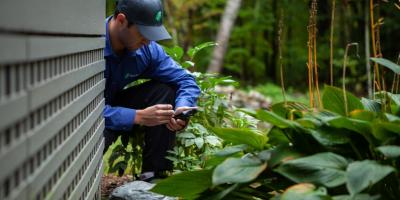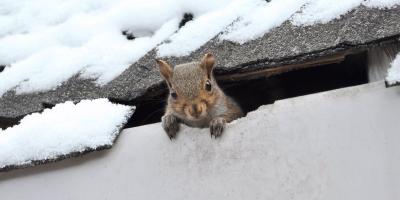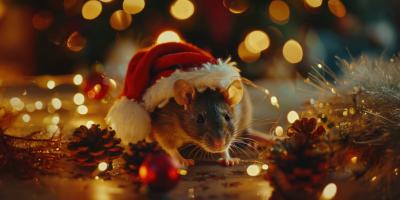Autumn Arthropods: 3 Hunting Spiders That Follow Prey Into New England Homes When The Temperature Drops

Most of the invaders that overwinter inside of homes fall under the “nuisance by numbers” category, meaning that they aren’t particularly harmful pests, but rather infest homes in such large numbers that homeowners feel the need to eradicate. Even if these innocuous pests are coming in small numbers, however, it is what follows them inside that makes most New Englanders squeamish.
Walking through a practically invisible spider web causes us unassuming humans to splay out in a fit of panic, frantically trying to shed the silky fibers from our bodies. This is a telltale way to know that spiders are in the area, eek! When it comes to active hunting spiders, though, there isn’t a web of warning for us to know of a potential spider infestation. Making matters worse for unsuspecting homeowners, most active hunting spiders seek their prey on a nocturnal schedule.
Understanding Spider Bites
When it comes to spider bites, it’s important to keep a few things in mind. The first is that there is a very distinct difference between being venomous and being harmful to humans. Almost all spiders are venomous, as the venom is a natural advantage used to subdue their prey. It shouldn’t come as any surprise that humans don’t fall under this category. Not only are we too big for spiders to eat, that size difference means that most spider venom hardly affects us at all. In fact, the CDC only lists two venomous spiders as medically significant: The Brown Recluse and Black Widow. Luckily for New Englanders, these two species are mostly found in the southern and western parts of the country.
Most spider venom doesn’t affect humans in the long-term, but that doesn’t mean that bites don’t initially hurt. Allergic reactions to venom or infections at the site of the bite can pose more serious health issues than the venom itself, thus all three of the spiders on our list are capable of packing a nasty bite. We’ll start with the most brazen offender.
The "Trigger Happy" Spider
The spider whose bite and appearance most resembles a Brown Recluse, interestingly enough, is the most aggressive arachnid on our list. The Yellow Sac Spider, or Longlegged Sac Spider, is recognized by many "deadliest spiders" lists. Though not applicable to human fatalities, these lists are comprised of species that don’t hesitate to use their venom.
Yellow Sac Spiders will bite, even repeatedly, when threatened. It has been noted that a lot of bites attributed to Brown Recluse spiders were actually those of Yellow Sac Spiders, as the severity of the bite was similar but far less threatening.
Like any other sac spider, these active hunters construct web masses, or sacs, that are usually in the corners where walls and ceilings meet. Unlike traditional webs, they are very compact and are essentially a hammock-like den for the spiders to hide in during the day. Scan your home for these cloudy web masses and the yellow, albino-like spiders that inhabit them to determine whether or not you have Yellow Sac Spiders roaming your halls for prey.
(Here’s a gallery to reference when trying to identify the Yellow Sac Spider)
The "Popular" Spider
"Popular" is an odd word to describe something most folks find frightening, but we actually just mean that this spider is the one on our list that is most commonly found in New England. The Broad-faced Sac Spider is another sac spider with similar tendencies to that of the Yellow Sac Spider. These spiders, however, are actually more likely to interact with humans as they regularly hunt prey inside of homes.
The Broad-faced Sac Spider is a much more sinister looking sac spider than most. It is easily identifiable, as the spider’s two front legs are strikingly more red than its hind legs which fade into the similar albino-like transparency of the Yellow Sac Spider. It has a dark, reddish-brown cephalothorax (body part where the legs are attached) and chelicerae (claw-like mouthparts, the “scary” part of spiders).
What differentiates the Broad-faced sac spider from other active hunters is that they will often scavenge dead insects for meals. This makes them arguably the most dangerous on the list, as the bacteria they consume via dead insects can cause infection when biting a human.
(Here’s a gallery to reference when trying to identify the Broad-faced Sac Spider)
The "Big Mouthed" Spider
Last on our list is a spider that is often mistaken for the Broad-faced Sac Spider, and though it looks like a more intimidating version, it is actually the least dangerous of the three listed here. The Woodlouse Hunter is nearly identical to the Broad-faced Sac Spider, with one major difference; the exceptionally long jaws (chelicerae) and fangs make it appear to be a menacing force of the arachnid community.
The Woodlouse Hunter has its meal of choice right in its name. This nightmarish looking spider exclusively feeds on woodlice, or sow bugs, and mostly stays on the ground to do so. A good way to tell the difference between the Broad-faced Sac Spider and the Woodlouse Hunter is that you will rarely find a Woodlouse climbing walls or ascending much higher than ground-level. If your home has a woodlice problem, you will likely see these spiders coming indoors to hunt them down.
(Here’s a gallery to reference when trying to identify the Woodlouse Hunter)
Keeping Spiders Out Of Your Home
Regardless of the type of spider and the severity of its bite, most New Englanders would prefer not to see potentially harmful arachnids crawling about their homes. As we mentioned above, a lot of these spiders are simply following their prey indoors. This means that, in order to keep spiders out, you must work towards keeping the other fall invaders out as well. Our ‘Fall Invaders’ program does just that. If you’re noticing a lot of spiders, you may have another pest at the root of the problem. Contact JP Pest Services for help in figuring out what exactly is bugging you this fall!



